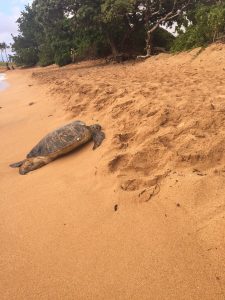One of the things that initially attracted me to my internship with Hawaii’s DLNR is that a major task would be to help craft a long-term state management plan for sea turtles. I was eager to get my hands dirty in some sea turtle work outside of the East Coast’s usual loggerhead suspects—the species I’d mainly worked with previously—and knew I wanted to work with turtles in a policy/management arena, rather than the direct field experience.
When I learned of that task, I remember thinking something along the lines of, “Piece of cake. I got this.”
How wrong I was.
In a nutshell: marine conservation and management in Hawaii, particularly when it comes to sea turtles, is a whole different ballgame than it is on the East Coast. Let me unpack some of the most obvious differences:
-
The most glaring difference is that there are eight Main Hawaiian Islands, each with some nesting and/or basking activity, and each with some unique management considerations. Not only that, but more than 90 percent of sea turtles nest in the remote French Frigate Shoals in the Northwestern Hawaiian Islands, which means that turtle management essentially extends throughout the Hawaiian archipelago. Each island has its own culture, unique ecological and geological setting, and different management requirements. In other words, a one-size-fits-all management package doesn’t fit the state of Hawaii the way it does much easier in a place like North Carolina.
-
There are two different species in Hawaii, as well as corresponding different population structures. Green (honu) and hawksbill (‘ea) sea turtles are found most prevalently here, whereas loggerheads comprise much of the nesting in the southeast, at least particularly in North Carolina. While their basic nesting behavior and biology is similar, there are some major differences to consider, such as adult green sea turtles being the only herbivorous sea turtle species. Additionally, even within Hawaii, both species found here have completely different population structures. Hawksbills are listed as endangered under the Endangered Species Act and not really showing signs of recovery, whereas greens (the Central North Pacific DPS—the population around Hawaii) are slowly increasing and listed as threatened.
-
Not only do sea turtles come ashore to nest in Hawaii, but green sea turtles also come ashore during the day to “bask,” where they haul out on beaches and sit motionless. Hawaii is one of the only places in the world where turtles exhibit such behavior. Scientists used to think sea turtles basked to thermoregulate, just like aquatic turtles do, but documented evidence of turtles also basking at night has thrown off the thermoregulation theory.
As much of a treat it is for East Coasters like myself to see sea turtles during the day, it makes management that much more complex. Not only do you have to ensure they can successfully nest at night, but one must ensure they have adequate room to bask on often populated beaches.

A green sea turtle (honu) basking in the late evening on the North Shore, Oahu.
-
In Hawaii, federal agencies (mostly the National Oceanic and Atmospheric Administration) have taken the lead on sea turtles. Back on the East Coast, it’s the states that play the ground-level role in sea turtle management, responding to strandings and coordinating intensive nest monitoring projects along the East Coast. Currently, this is just the way management is done, but this was difficult to wrap my head around.
-
Finally, turtles out here face a range of different threats than they do on the East Coast. Out here, the most prevalent threat is disease—fibropapillomatosis, to be exact, which causes tumor growth on turtles that can lead to basic behavioral obstruction. Back on the East Coast, the primary threat is incidental capture in fishing gear, according to NOAA, though this also impacts turtles around Hawaii.
So, now with this basic background and understanding established (which for the purpose of this blog only begins to scrape the surface of the landscape in Hawaii surrounding sea turtles), I have spent much of my time working on this report. And, developing this list isn’t as glamorous as it seems. It involves little field work and a lot of time behind a desk reading studies and reports.
This management plan will also complement extensive work already being done by the state, other conservation groups, and federal agencies. For instance, the state and NOAA have partnered for their FAST program (Fishing Around Sea Turtles) and the Barbless Circle Hook Project, which both push for responsible fishing around sea turtles and other protected species.
By combining a plan that is rooted in science, local ecology, and that includes specifications to each Hawaiian Island (that is a tricky part!), you can start to craft a sea turtle management plan—one in which sea turtles can coexist with people into the future, especially as Hawaii only becomes more populated in the coming years.


